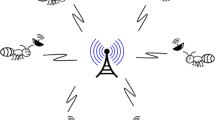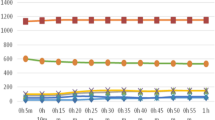Abstract
A MANET is a wireless ad hoc network with neither a fixed infrastructure nor an administrator to monitor the network operations. Clustering the network helps manage the network better. MANETs are networks that are ad hoc in nature. This nature gives rise to issues like loss of packets, security etc. which needs to be addressed in order to make the network more efficient. One major problem in clustering is the delay involved in cluster formation and in the selection of a suitable cluster head. We have proposed an improved version of the ant colony algorithm that employs two strategies to deduce the movement of the nodes and use this information to reduce the overheads in communication. The first phase helps to dynamically determine the heuristic parameters of the network in order to select the appropriate nodes for the cluster. The second phase helps form clusters faster and selects the cluster head without any delay. A distinct dynamic broadcast algorithm is employed to transmit the node status throughout the network. This algorithm also helps the network to sustain the changes in the network with no hindrance to data transmission. This technique helps in reducing the communication overheads and also improves the efficiency of transmission in the network. The proposed algorithm exploits the features of the ant colony algorithm and improvises it to achieve maximum delivery of packets with minimal delay possible. The proposed algorithm also focuses on reducing the time delay usually associated with cluster formation and cluster head selection. The node information helps in reducing this delay and helps the network focus on data transmission. The advantage of this algorithm is that the cluster head is determined based on the node movement and is immediately selected when the cluster is formed.
Access this article
We’re sorry, something doesn't seem to be working properly.
Please try refreshing the page. If that doesn't work, please contact support so we can address the problem.












Similar content being viewed by others
References
Nishitha, T., & Chenna Reddy, P. (2012). Performance evaluation Of AntHocNet routing algorithm in ad hoc networks. In IEEE ICCS.
Shivaprakash, T., Aravinda, C., Deepak, A. P., Kamal, S., Mahantesh, H. L., Venugopal, K. R., et al. (2005). Efficient passive clustering and gateway selection in MANETs. In IWDC. Springer, Berlin.
Sathiamoorthy, J., Ramakrishnan, B., & Usha, M. (2015). Design of a competent broadcast algorithm for reliable transmission in CEAACK MANETs. Journal of Network Communications and Emerging Technologies, 5(1), 144–151.
Ramakrishnan, B. Analytical study of cluster and sans cluster vehicular adhoc network communication. International Journal of Computer Engineering and Information Technology, IJCEIT ISSN 0974-2034 2010/9.
Bokhari, M. U., Hamatta, H. S. A., & Siddigui, S. T. (2012). A review of clustering algorithms as applied in MANETs. International Journal Advanced Research in Computer Science and Software Engineering, 2(11), 364–369.
Sampath, A., Tripti, C., Sabu, M., Thampi, An ACO algorithm for effective cluster head selection.
Jiang, M., Li, J. & Tay, Y. C. Cluster based routing protocol (CBRP) functional specification. INTERNET-DRAFT draft-ietf-manet-cbrp-spec-Feb-2000.
Agarwal, R., & Motwani, M. (2009). Survey of clustering algorithms for MANET. International Journal on Computer Science and Engineering, 1(2), 98–104.
Camara, D., & Loureiro, A. A. F. (2000). A novel routing algorithm for ad hoc networks. In 33rd Hawaii International Conference on System Sciences—IEEE.
Mohamed Jafar, O. A., & Sivakumar, R. (2010). Ant-based clustering algorithms: A brief survey. International Journal of Computer Theory and Engineering, 2(5), 1793–8201.
Acampora, G., et al. (2010). Interoperable and adaptive fuzzy services for ambient intelligence applications. ACM Transactions on Autonomous and Adaptive Systems (TAAS), 5(2), 8.
Krishan, P. (2013). A study on dynamic and static clustering based routing schemes for wireless sensor networks. International Journal of Modern Engineering Research (IJMER), 3(2), 1100–1104.
Ramakrishnan, B., Rajesh, R. S., & Shaji, R. S. (2011). Analysis of routing protocols for highway model without using roadside unit and cluster. International Journal of Scientific & Engineering Research, 2(1), 1–9.
Camp, T., Belong, J., & Davies, V. (2000). A survey of mobility models for ad hoc network research. Wireless Communications and Mobile Computing, 2, 483–502.
Khabbazian, M., Blake, I. F., & Bhargava, V. K. (2011). Local broadcast algorithms in wireless ad hoc networks: Reducing the number of transmissions. IEEE Transactions on Mobile Computing, 11(3), 402–413.
Khabbazian, M., & Bhargava, V. K. (2008). Localized broadcasting with guaranteed delivery and boundedtransmission redundancy. IEEE Transactions on Computers, 57(8), 1072–1086.
Khabbazian, M., & Bhargava, V. K. (2009). Effcient broadcasting in mobile ad hoc networks. IEEE Transactions on Mobile Computing, 8(2), 231–245.
Wu, J., & Dai, F. (2003). Broadcasting in ad hoc networks based on self pruning. In Proceedings IEEEINFOCOM (pp. 2240–2250).
Ramakrishnan, B., Rajesh, R. S., & Shaji, R. S. (2011). CBVANET: A cluster based vehicular adhoc network model for simple highway communication. International Journal of Advanced Networking and Applications, 2(4), 755–761.
Preethi, S., & Ramachandran, B. (2011). Energy efficient routing protocols for mobile adhoc networks. IEEE International Conference on Emerging Trends in Networks and Computer Communications, 3, 136–141.
Nand, P., & Sharma, S. C. (2011). Comparative analysis of broadcasting techniques for routing protocols. IEEE International Conference on Devices and Communications, 2, 1–5.
Wu, J., & Dai, F. (2004). A generic distributed broadcast scheme in ad hoc wireless networks. IEEE Transactions on Computers, 53(10), 1343–1354.
Nand, P., & Sharma, S. C. (2011). Probability based improved broadcasting for AODV routing protocol. IEEE International Conference on Computational Intelligence and Communication Networks, 2, 621–625.
Dembla, D., & Chaba, Y. (2010). Performance modeling of efficient and dynamic broadcasting algorithm in MANETs routing protocols. IEEE International Conference on Computer Research and Development, 2, 421–425.
Singh S. K., Singh M. P., Singh, D. K. (2011). Intrusion detection based security solution for cluster-based wireless sensor networks. International Journal of Advanced Science and Technology, 30, 9–11.
Zheng, J., & Jamalpour, A. (2009). Wireless sensor networks: A networking perspective. New York: IEEE.
Su, C. C., Chang, K. M., Kue, Y. H., & Horng, M. F. (2005). The new intrusion prevention and detection Approaches for clustering-based sensor networks. In Proceedings of 2005 IEEE Wireless Communications and Networking Conference (WCNC’05) (Vol. 4, pp. 1927–1932) New Orleans, L.A.
Youssef, M., et al. (2014). Routing metrics of cognitive radio networks: A survey. IEEE Communications Surveys and Tutorials, 16(1), 92–109.
Dvir, A., & Vasilakos, A. V. (2011). Backpressure-based routing protocol for DTNs. ACM SIGCOM Computer Communication Review, 41(4), 405–406.
Zhang, X. M., Zhang, Y., Yan, F., & Vasilakos, A. V. (2015). Interference-based topology control algorithm for delay-constrained mobile ad hoc networks. IEEE Transactions on Mobile Computing, 14(4), 742–754.
Sathiamoorthy, J., & Ramakrishnan, B. (2016). CEAACK—A reduced acknowledgment for better data transmission for MANETs. International Journal of Computer Network and Information Security, 2, 64–71.
Shakshuki, E. M., Kang, N., & Sheltami, T. R. (2013). EAACK—A secure intrusion-detection system for MANETs. IEEE Transactions on Industrial Electronics, 60(3), 1–10.
Author information
Authors and Affiliations
Corresponding author
Rights and permissions
About this article
Cite this article
Sathiamoorthy, J., Ramakrishnan, B. Energy and Delay Efficient Dynamic Cluster Formation Using Improved Ant Colony Optimization Algorithm in EAACK MANETs. Wireless Pers Commun 95, 1531–1552 (2017). https://doi.org/10.1007/s11277-016-3864-x
Published:
Issue Date:
DOI: https://doi.org/10.1007/s11277-016-3864-x




